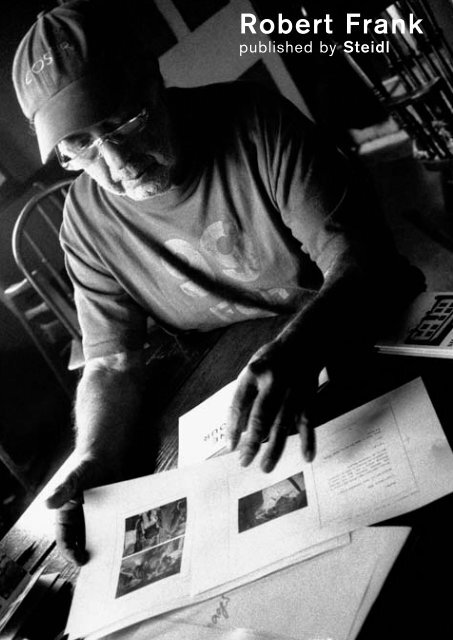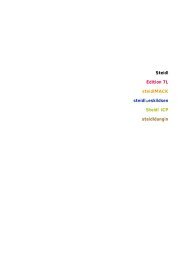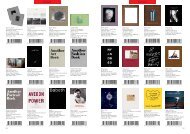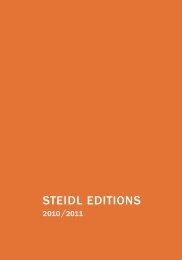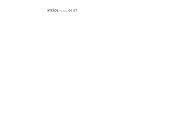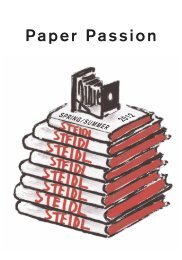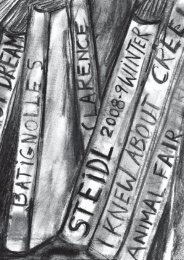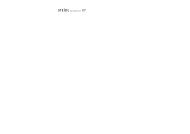The Robert Frank Project - Steidl
The Robert Frank Project - Steidl
The Robert Frank Project - Steidl
Create successful ePaper yourself
Turn your PDF publications into a flip-book with our unique Google optimized e-Paper software.
<strong>Robert</strong> <strong>Frank</strong><br />
published by <strong>Steidl</strong>
<strong>The</strong> <strong>Robert</strong> <strong>Frank</strong> <strong>Project</strong><br />
“<strong>The</strong> <strong>Robert</strong> <strong>Frank</strong> <strong>Project</strong>” is an ambitious long term publishing programme which<br />
encompasses <strong>Robert</strong> <strong>Frank</strong>’s complete oeuvre – reprints of his classic books, reprints<br />
of some less well known small books, the publica tion of previously unseen projects,<br />
newly conceived bookworks, and his Complete Film Works in specially designed col-<br />
lector’s DVD sets. This ensures the legacy of this original and seminal artist and that<br />
<strong>Robert</strong> <strong>Frank</strong>’s work will be available and accessible for many years to come in a sche-<br />
me and to a standard that the artist himself has overseen.<br />
<strong>The</strong> publication of a new edition of “<strong>The</strong> Americans” on 15th May, 2008, the fiftieth<br />
anniversary of the first edition, is the fulcrum of <strong>The</strong> <strong>Robert</strong> <strong>Frank</strong> <strong>Project</strong>. It presages<br />
a major touring exhibition and accompanying catalogue from the National Gallery of<br />
Art, Washington D.C., “Looking In: <strong>Robert</strong> <strong>Frank</strong>’s <strong>The</strong> Americans”, which opens in<br />
January 2009.<br />
This brochure contains details of all the books and films which are currently available<br />
and those planned for the future.<br />
Gerhard <strong>Steidl</strong> Ute Eskildsen Laura Israel<br />
Publisher Editorial Adviser Film Works Adviser
Delpire, 1958 Il Saggiatore, 1959<br />
Grove Press, 1959<br />
Aperture, 1969 Christian, 1986<br />
Delpire, 1993<br />
Scalo, 1993 Scalo, 2000
A Short Publishing History of “<strong>The</strong> Americans”<br />
by Monte Packham<br />
<strong>Robert</strong> <strong>Frank</strong>’s “<strong>The</strong> Americans” was first published in 1958 by<br />
<strong>Robert</strong> Delpire in Paris. It featured 83 of <strong>Frank</strong>’s photographs taken in<br />
America in 1955 and 1956, accompanied by writings in French about<br />
American political and social history selected by Alain Bosquet.<br />
Delpire’s “Les Américains” formed part of the Encyclopédie essentielle<br />
series, which presented foreign countries to a French audience.<br />
Each of <strong>Frank</strong>’s photographs in this edition is placed on a right-hand<br />
page, with the texts on the left-hand pages.<br />
<strong>The</strong> first English edition of “<strong>The</strong> Americans” was published in 1959 by<br />
Grove Press in New York. It presented the same photographs as the<br />
Delpire edition, but a text by Jack Kerouac replaced the French writings.<br />
<strong>The</strong> book begins with Kerouac’s introduction, followed by<br />
<strong>Frank</strong>’s photographs in the same sequence as the Delpire edition. On<br />
the left-hand pages are short captions from <strong>Frank</strong>, which describe the<br />
location.<br />
Since 1959 “<strong>The</strong> Americans” has been reprinted by different publishers,<br />
in multiple languages and formats. <strong>Frank</strong> has had varying influence<br />
on these editions; some were printed without his input, approval<br />
or know ledge. When the <strong>Steidl</strong> edition of “<strong>The</strong> Americans” was printed,<br />
<strong>Frank</strong> was involved in every step of its design and production. <strong>The</strong><br />
83 photographs were scanned in tritone from vintage prints in <strong>Frank</strong>’s<br />
collection, which revealed that many images in past editions were<br />
actually crops of the originals. For the <strong>Steidl</strong> book <strong>Frank</strong> studied and<br />
revised these crops and in many cases included the full photographs.<br />
<strong>The</strong> <strong>Steidl</strong> edition also reproduces two photographs printed from<br />
negatives different to those used for all previous editions. <strong>The</strong>se<br />
photographs depict the same two subjects as in other editions (“Metropolitan<br />
Life Insurance Building–New York City” and “Assembly<br />
Line–Detroit”) but from a slightly different perspective.<br />
Kerouac’s text and <strong>Frank</strong>’s captions remain unaltered from the Grove<br />
Press edition, the typography however was redesigned. As well as<br />
revising the book’s design, <strong>Frank</strong> selected the paper, endpaper and<br />
book linen. He opted for a thread-stitched book, and conceived a new<br />
dust jacket made from the same paper as in the book (Xantur 170 g<br />
from Scheufelen), sealing it with a simple varnish. <strong>Frank</strong> personally<br />
oversaw printing on July 18, 2007, inspecting and approving each<br />
sheet at <strong>Steidl</strong>’s press in Göttingen.<br />
<strong>Steidl</strong> / National Gallery of Art, Washington, 2008<br />
Pages from a handmade maquette, showing the full<br />
size of the scanned vintage prints. <strong>The</strong> red rectangles<br />
show the crops in the Delpire and Grove Press editions,<br />
which except in one instance, <strong>Frank</strong> altered for<br />
the <strong>Steidl</strong> edition.
50 th ANNIVERSARY EDITION<br />
<strong>Robert</strong> <strong>Frank</strong> “<strong>The</strong> Americans”<br />
“Few books in the history of photography have had as powerful an impact as ‘<strong>The</strong> Americans’”–<br />
<strong>The</strong> New York Times.<br />
<strong>The</strong> worldwide release of a new edition of “<strong>The</strong> Americans” on May 15, 2008, will be accompanied<br />
by extensive media coverage, launch events, in-store co-ops and both trade and consumer<br />
advertising.<br />
In January 2009 the National Gallery of Art, Washington, will celebrate the 50th anniversary of<br />
“<strong>The</strong> Americans” with an exhibition that will examine both the contsruction of the book and the<br />
photographs themselves. “Looking In: <strong>Robert</strong> <strong>Frank</strong>’s <strong>The</strong> Americans” will tour to the San Fransisco<br />
Museum of Modern Art and <strong>The</strong> Metropolitan Museum of Art, New York. <strong>The</strong> exhibition will<br />
be accompanied by a fully illustrated catalogue.<br />
<strong>Robert</strong> <strong>Frank</strong> was born in Zurich, Switzerland in 1924 and went to the United States in 1947.<br />
He is best known for his seminal book “<strong>The</strong> Americans”, first published in 1958, which gave rise<br />
to a distinct new art form in the photo-book, and his experimental film “Pull My Daisy”, made in<br />
1959. His other important projects include the book “Black White and Things”, 1954, the book<br />
“<strong>The</strong> Lines of My Hand”, 1959, and the film “Cocksucker Blues” for the Rolling Stones, 1972.<br />
He divides his time between New York City and Nova Scotia, Canada.<br />
<strong>Robert</strong> <strong>Frank</strong><br />
<strong>The</strong> Americans<br />
Introduction by Jack Kerouac<br />
Book design by <strong>Robert</strong> <strong>Frank</strong>, Gerhard <strong>Steidl</strong> and Claas Möller<br />
180 pages with 83 tritone plates<br />
8.25 x 7.25 in./20.9 x 18.4 cm<br />
Clothbound hardcover with dust jacket<br />
US$39.95/£20.00/€30.00<br />
English Edition: 978-3-86521-584-0<br />
German Edition: 978-3-86521-658-8<br />
Chinese Edition: 978-3-86521-657-1 (RMB 288)
<strong>Robert</strong> <strong>Frank</strong> in Göttingen<br />
by Joel Sternfeld<br />
<strong>Robert</strong> <strong>Frank</strong> and I must have made an interesting sight that warm July afternoon on Düstere Strasse.<br />
We resemble each other but he is older than I so no matter what we were up to we could have made<br />
sense as father/son.<br />
And in one important sense we were: when I was becoming a photographer in the late 1960s, his<br />
book, “<strong>The</strong> Americans” was already a landmark–that’s much too weak a word but what other word for<br />
a body of work that changed the course of the river of Photography in a way that it could never take<br />
the old course again.<br />
I would look at it before I went to sleep and in the morning I would reach for it like a smoker reaches<br />
for a cigarette. I needed to see it again. <strong>The</strong> country was so bleak in those sooty pages, each one an<br />
artifact ripped from the landscape and brought straight to the bindery. <strong>Frank</strong> had found a way to give<br />
form to the formless lives that went unmilled in America.<br />
Two years before I encountered his book I had taken my first cross-country trip–three of us in an<br />
immense gold driveaway car that needed to be delivered to its owner in Los Angeles. We sailed from<br />
the East Coast to the West in less than three days–one of us sleeping across the back seat, one up<br />
front trying to stay awake with the driver.<br />
It was December. We angled into New Mexico as the sun was going down and pulled into an A. and<br />
W. Root Beer stand. <strong>The</strong> dirt parking lot seemlessly joined the desert and the desert night. A cold wind<br />
came up as the sky turned black–the same cold wind every traveller without a room feels as the sun<br />
goes down.<br />
A wrapper from someone’s fries blew into the desert in a moment of Americanized infinity. <strong>Frank</strong>’s<br />
book reminded me of that moment. And now here he was on Düstere Strasse in Göttingen and here<br />
I was beside him. Inside at <strong>Steidl</strong> “<strong>The</strong> Americans” was being printed–the reproductions were to be<br />
as close a match as possible to the Delpire edition that had set Photography on its fat ear when it first<br />
come out in 1958.<br />
A very tired, 83 year-old <strong>Robert</strong> had come to Germany from Switzerland to supervise the printing–presumably<br />
the final edition of the book. I thought about the apocryphal tale of the young <strong>Robert</strong><br />
<strong>Frank</strong> kicking in the swinging doors of a cowboy bar in Nevada, hollering in “you mother fuckers,”<br />
before taking the picture and then running like hell. No running now but the mischief was still in his<br />
smile.<br />
He had come to Europe to receivie a prize in Spain but the real agenda was to try out the Switzerland<br />
of his childhood as a place to come for his final days. Surprisingly, it had failed in that regard. <strong>Robert</strong><br />
wanted to go home–to America.<br />
“You can’t go home again. Home hasn’t changed, you have.” How many others in a borderless world<br />
would face this dilemma?<br />
<strong>The</strong> printing had been going on for two days and it was going well. <strong>Steidl</strong> was utterly himself–unshaved<br />
and getting things done. <strong>Robert</strong> was being especially sweet to everyone despite his exhaustion. I noted<br />
the care he took when he autographed books for <strong>Steidl</strong> staffers who timidly came up the stairs to the<br />
library. He took sincere interest in the work of other artists who waited in the library like it was a pitch-<br />
Photograph by Joel Sternfeld
er’s bull pen–we were ready for the nod that would allow us to go downstairs to press.<br />
He especially remarked a postcard that was being printed for Tacita Dean. It was of an olive tree in<br />
Spain that she had designated to be the one beneath which García Lorca and Salvador Dalí had conducted<br />
their suspected tryst. <strong>Robert</strong> pronounced it beautiful and asked her to sign one for him–for his<br />
postcard collection.<br />
Earlier in the afternoon I had gone downstairs to watch as <strong>Robert</strong> corrected his sheets. I was taken<br />
aback by the precision of his memory of the Delpire edition. From the comments <strong>Robert</strong> was making<br />
I could see it wasn’t just the first edition he was remembering–it was the moments out there, in 1950s<br />
America and how they had looked. <strong>The</strong> realization gave me a chill.<br />
Here we were in the garden outside the press–I don’t know if it was for the flat light, or for the pleasure<br />
of a summer day but Gerhard had placed an easel out the doors. <strong>Robert</strong> was trying to “open up”<br />
a person you can barely see behind the passengers in the windows of the streetcar in New Orleans.<br />
A bird came up and pulled my eye on as I tried to think about the provenance of the moment.<br />
Every few minutes he would speak of his exhaustion and of his desire to go back to his hotel room but<br />
when a sheet came out his comments were acute–a lion always sleeps with one eye open. Later in<br />
the afternoon I went down to the carless street–none of the streets in Göttingen permit automobile<br />
traffic–and saw <strong>Robert</strong> wandering in the middle of the bricked roadway. He was ambling. I went up<br />
and asked him where he was going. He said he was going to hail a taxi and go to his hotel. One of us<br />
made a joke about escaping–Gerhard likes to picture himself as sheriff.<br />
I told <strong>Robert</strong> I didn’t think there were any taxis to be hailed but if he would just come back inside and<br />
finish the last form a taxi could be called. <strong>Robert</strong> made no direct response but he seemed glad of my<br />
company and he suggested that we go into the antique store across the street so he could look for<br />
postcards. (For a guy thinking about the end of things he was certainly keen about keeping his postcard<br />
collection up. Perhaps this was in the daytime: in the middle of the night there are no postcards<br />
to be collected.)<br />
I went into “Kitsch & Kunst” with him–now I was AWOL too. <strong>The</strong>re weren’t really any postcards but<br />
there were some albums of family trips–journeys long ago cornered into sheets and now for sale.<br />
As <strong>Robert</strong> leafed through them I went back to Gerhard to appraise him of the situation. He asked me to<br />
bring <strong>Robert</strong> back to press: the men were waiting, the press was idle.<br />
What followed next is difficult to describe. <strong>Robert</strong> came out into the street and for the next hour he did<br />
a sort of performance. It was a dance of remembrance and reluctance with commentary by the performer<br />
interspersed.<br />
In the grey July afternoon he appeared to be weightless–a trained bear doing slow-motion pirouettes.<br />
He butoh’d toward the door to <strong>Steidl</strong> but the closer he got to it, the more interesting everything outside<br />
it became. He would turn in the street, float up to a rain gutter and tap it. “I just wanted to see if<br />
it’s made out of lead,” he explained as his eyes followed it up to the roof. He went back into the street,<br />
pirouetted again and came back to the wall as his arms floated up a ledge which was at shoulder<br />
height. Did he know that he looked like Christ on the cross as he spoke of his desire to return to<br />
America? Of what a good country it was–it had given him his chance.<br />
I thought about “home” and its power; and about an idea I have that many of the great practitioners<br />
photograph their “home” landscapes. I had excluded <strong>Frank</strong> from my thesis because America was not<br />
his home–but now it was. A phrase, “I did not choose this place but now I am of it” came to mind.
<strong>The</strong> moment was broken by a man with a sort of flame thrower. It was a blow torch with a three-foot<br />
extension tube off the nozzle so that a small flame could be used to burn weeds coming up through<br />
cracks in the sidewalk. <strong>Robert</strong> feigned fascination and he began questioning the operator of the<br />
device–soon others joined the conversation and there was a general discussion of the topic of weed<br />
killing with <strong>Robert</strong> a full discussant.<br />
Eventually, after various other petite excursions <strong>Robert</strong> went in and finished the form. <strong>The</strong> next day he<br />
was in the library in a dark blue shirt and a baseball cap–shaved and with his hair combed he looked<br />
25 years younger. His body had solidity–he was flying home from <strong>Frank</strong>furt that afternoon.<br />
Seeing him so transformed helped me to understand what I had witnessed the day before. Of course he<br />
was avoiding–why would he want to come in and say goodbye to the work of his youth? Didn’t he tell us<br />
he was “sick of goodbyes”? Of course it was exhausting–putting a closure on the work that had defined<br />
a life must be. Which one of us would willingly approve a “final edition”?<br />
I remembered these words, “there is no strange behavior it’s just that some behavior requires more<br />
understanding than other behavior.”<br />
Faced with no good choices <strong>Robert</strong> <strong>Frank</strong> did a dance.<br />
Photographs by Joel Sternfeld
Zurich, Saturday 14.07.07:<br />
Hotel Helmhaus<br />
Tuesday, 17.07.07: last corrections<br />
Final approval of a handmade maquette<br />
Monday, 16.07.07 at <strong>Steidl</strong>ville<br />
Tritone printing: inspecting density variations to fix the final level of black ink to be mixed with the two greys<br />
Farewell to Joel Sternfeld<br />
Wednesday, 18.07.07, 6:20 am: printing commences on the brand-new Roland 706 press<br />
Departing from <strong>Steidl</strong>ville to <strong>Frank</strong>furt airport<br />
Test prints for the dust jacket with differ<br />
Pa
Finalizing crops on each of the photographs<br />
Dust jacket design<br />
Discussing dust jacket variations<br />
st editions of “<strong>The</strong> Americans” including the original 1958 Delpire book, and vintage prints were on hand at press<br />
nt varnishes<br />
Saturday, 04.08.07: checking the<br />
finished book at Bleeker Street,<br />
New York<br />
Checking the dust jacket in daylight<br />
In the evening the last printed sheets are moved to dry<br />
<strong>Robert</strong> <strong>Frank</strong> signs the first<br />
book of the first printrun<br />
of the <strong>Steidl</strong> edition<br />
Checking the Xantur paper from Scheufelen<br />
Tacita Dean showing her limited edition<br />
postcard “Lorca’s Olive”, printed at<br />
<strong>Steidl</strong> on the same day<br />
Photographs by Gerhard <strong>Steidl</strong>
Currently Available<br />
One Hour<br />
ISBN 978-3-86521-364-8<br />
Zero Mostel Reads a Book<br />
ISBN 978-3-86521-586-4<br />
Pull My Daisy<br />
ISBN 978-3-86521-673-1<br />
New York to Nova Scotia<br />
ISBN 978-3-86521-013-5<br />
Peru<br />
ISBN 978-3-86521-692-2<br />
Storylines<br />
ISBN 978-3-86521-041-8
London/Wales<br />
ISBN 978-3-86521-362-4<br />
Paris<br />
ISBN 978-3-86521-524-5 (English edition)<br />
ISBN 978-3-86521-544-4 (French edition)<br />
ISBN 978-3-86521-754-7 (German edition)<br />
Come Again<br />
ISBN 978-3-86521-261-0<br />
Me and My Brother<br />
ISBN 978-3-86521-363-1<br />
<strong>The</strong> Americans<br />
ISBN 978-3-86521-584-0 (English edition)<br />
ISBN 978-3-86521-658-8 (German edition)<br />
ISBN 978-3-86521-657-1 (Chinese edition)<br />
<strong>Robert</strong> <strong>Frank</strong><br />
<strong>The</strong> Complete Film Works<br />
Vol. 1: ISBN 978-3-86521-365-5<br />
Vol. 2: ISBN 978-3-86521-525-3<br />
Vol. 3: ISBN 978-3-86521-591-8
<strong>The</strong> Complete Film Works Volumes 1– 10<br />
<strong>The</strong> Complete Film Works consists of 10 volumes which together en compass <strong>Robert</strong> <strong>Frank</strong>’s entire oeuvre in film<br />
and video in chronological sequence. Each volume will consist of 3 or more films, each film on a separate DVD<br />
housed in a film-tin, and all the tins of a volume contained in an archive-box.<br />
Volume 1 – Spring 2008:<br />
Pull My Daisy – 28 minutes – 1959<br />
<strong>The</strong> Sin of Jesus – 40 minutes – 1961<br />
Me and My Brother – 85 minutes – 1968<br />
Volume 2 – Spring 2008:<br />
OK End Here – 30 minutes – 1963<br />
Conversations in Vermont – 26 minutes – 1969<br />
Liferaft Earth – 37 minutes – 1969<br />
Volume 3 – Spring 2008:<br />
About Me: A Musical – 35 minutes – 1971<br />
Keep Busy – 38 minutes – 1975<br />
S-8 Stones Footage from Exile on Main St. – 5 minutes – 1971<br />
Volume 4 – Fall 2008:<br />
[Cocksucker Blues – 90 minutes – 1972]<br />
Life Dances On... – 30 minutes – 1980<br />
Energy and How to Get It – 28 minutes – 1981<br />
Volume 5 – Spring 2009:<br />
Home Improvements – 30 minutes – 1985<br />
This Song for Jack – 30 minutes – 1983<br />
Ginsberg/Corso Reading – Harry Smith-Herbert Hunck<br />
Volume 6 – Fall 2009:<br />
Hunter – 37 minutes – 1989<br />
C’est vrai (One Hour) – 60 minutes – 1990<br />
Candy Mountain – 91 minutes – 1987<br />
Volume 7 – Spring 2010:<br />
Run/New Order – 4 1/2 minutes – 1989<br />
Last Supper – 52 minutes – 1992<br />
Moving Pictures – 30 minutes – 1994<br />
Volume 8 – Fall 2010:<br />
<strong>The</strong> Present – 24 minutes – 1996<br />
Summer Cannibals/Patti Smith – 4 minutes – 1996<br />
Flamingo – 10 minutes – 1996<br />
Volume 9 – Fall 2010:<br />
What I Remember from my Visit (with Stieglitz) – 7 minutes – 1998<br />
San Yu – 27 minutes – 2000<br />
Fragments – 5 minutes – 2000<br />
Volume 10 – Fall 2010:<br />
Paper Route – 30 minutes – 2002<br />
<strong>The</strong> Tunnel – 5 minutes – 2005<br />
True Story – 30 minutes – 2004<br />
Egypt Δ 1995/96 – 2006
Publications to come in 2009 and 2010<br />
Polaroids<br />
Hold Still, Keep Going<br />
Henry <strong>Frank</strong>, Stereo-Photos<br />
Black White and Things<br />
Egypt Δ 1995 / 96 (book and DVD)<br />
<strong>The</strong> Hunter (book and DVD)<br />
40 Photos<br />
<strong>Frank</strong> Films<br />
edited by Brigitta Burger-Utzer / Stefan Grissemann<br />
National Gallery of Art, Washington D.C.<br />
A 50 th -anniversary celebration of <strong>Frank</strong>’s book<br />
National Gallery of Art, Washington D.C.,<br />
January 18–April 26, 2009<br />
San Francisco Museum of Modern Art,<br />
May 17–August 23, 2009<br />
<strong>The</strong> Metropolitan Museum of Art, New York,<br />
September 20 – December 27, 2009<br />
Looking In: <strong>Robert</strong> <strong>Frank</strong>’s “<strong>The</strong> Americans”<br />
edited by Sarah Greenough<br />
ISBN 978-3-86521-748-6<br />
Co-Published by National Gallery of Art and <strong>Steidl</strong><br />
in conjunction with the exhibition
How to order<br />
Germany, Austria<br />
and Switzerland<br />
<strong>Steidl</strong> Verlag<br />
<strong>Robert</strong> Walther<br />
Düstere Str. 4<br />
37073 Göttingen<br />
Germany<br />
Tel.: +49 551 49 60 612<br />
Fax: +49 551 49 60 649<br />
dotten@steidl.de<br />
French Language Titles<br />
Patrick Remy<br />
22, Place Charles Fillion<br />
75017 Paris<br />
France<br />
Tél.: +33 (0)1 40 05 08 10<br />
Fax.: +33 (0)1 40 05 08 19<br />
contact@inextensodiffusion.com<br />
www.inextensodiffusion.com<br />
USA and Canada<br />
D.A.P.<br />
155 Sixth Avenue, 2nd Floor<br />
New York, NY 10013–1507<br />
USA<br />
Tel.: +1 212 627 1999<br />
Fax: +1 212 627 9484<br />
dap@dapinc.com<br />
All other territories<br />
Thames & Hudson Ltd.<br />
181a High Holborn<br />
London WC1V 7QX<br />
United Kingdom<br />
Tel.: +44 20 7845 5000<br />
Fax: +44 20 7845 5055<br />
sales@thameshudson.co.uk<br />
Press enquiries<br />
Germany, Austria<br />
and Switzerland<br />
<strong>Steidl</strong> Verlag<br />
Claudia Glenewinkel<br />
Düstere Str. 4<br />
37073 Göttingen<br />
Germany<br />
Tel.: +49 551 49 60 650<br />
Fax: +49 551 49 60 644<br />
cglenewinkel@steidl.de<br />
French Language Titles<br />
Patrick Remy<br />
22, Place Charles Fillion<br />
75017 Paris<br />
France<br />
Tel: +33 1 4263 2167<br />
Fax: +33 1 4226 5518<br />
patremy2@wanadoo.fr<br />
USA and Canada<br />
D.A.P.<br />
Alexander Galan<br />
155 Sixth Avenue, 2nd Floor<br />
New York, NY 10013–1507<br />
USA<br />
Tel.: +1 212 627 1999 Ext. 211<br />
Fax: +1 212 627 9484<br />
agalan@dapinc.com<br />
All other territories<br />
<strong>Steidl</strong>Mack<br />
Vale Studio<br />
62 Wood Vale<br />
London SE23 3ED<br />
United Kingdom<br />
Tel: +44 20 8299 8847<br />
Fax: +44 20 8299 8827<br />
press@steidlville.com<br />
www.steidlville.com
s<br />
Düstere Str.4 37073 Göttingen Germany Tel +49 551 496 060 Fax +49 551 496 0649<br />
mail@steidl.de www.steidl.de To order our books visit www.steidlville.com


